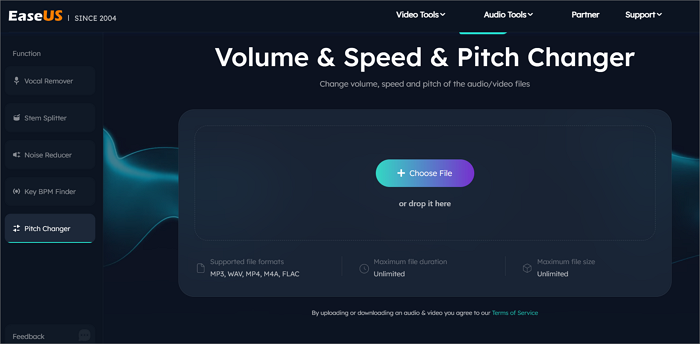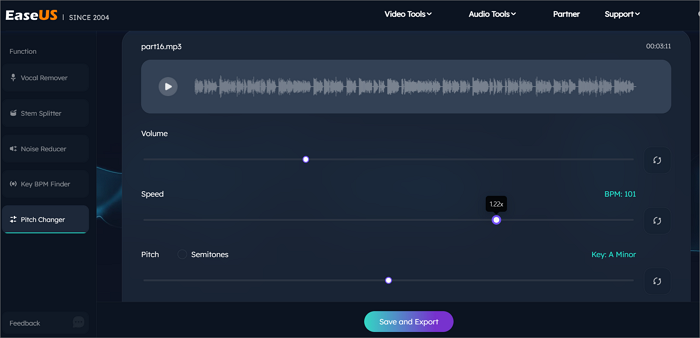-
![]()
Sofia Albert
Sofia has been involved with tech ever since she joined the EaseUS editor team in March 2011 and now she is a senior website editor. She is good at solving various issues, such as video downloading and recording.…Read full bio -
![]()
Melissa Lee
Melissa Lee is a sophisticated editor for EaseUS in tech blog writing. She is proficient in writing articles related to screen recording, voice changing, and PDF file editing. She also wrote blogs about data recovery, disk partitioning, data backup, etc.…Read full bio -
Jean has been working as a professional website editor for quite a long time. Her articles focus on topics of computer backup, data security tips, data recovery, and disk partitioning. Also, she writes many guides and tutorials on PC hardware & software troubleshooting. She keeps two lovely parrots and likes making vlogs of pets. With experience in video recording and video editing, she starts writing blogs on multimedia topics now.…Read full bio
-
![]()
Gorilla
Gorilla joined EaseUS in 2022. As a smartphone lover, she stays on top of Android unlocking skills and iOS troubleshooting tips. In addition, she also devotes herself to data recovery and transfer issues.…Read full bio -
![]()
Rel
Rel has always maintained a strong curiosity about the computer field and is committed to the research of the most efficient and practical computer problem solutions.…Read full bio -
![]()
Dawn Tang
Dawn Tang is a seasoned professional with a year-long record of crafting informative Backup & Recovery articles. Currently, she's channeling her expertise into the world of video editing software, embodying adaptability and a passion for mastering new digital domains.…Read full bio -
![]()
Sasha
Sasha is a girl who enjoys researching various electronic products and is dedicated to helping readers solve a wide range of technology-related issues. On EaseUS, she excels at providing readers with concise solutions in audio and video editing.…Read full bio
Content
What Is Davinci Resolve?
Step-Tutorial of Speed Change in Davinci Resolve
Alternative: Change the Speed of Clips with an Online Speed Changer
In-Closing
FAQ
793 Views |
6 min read
Highlights:
- To change the speed of a clip in DaVinci Resolve: Select the clip in the timeline > open the Inspector panel > adjust the speed percentage slider under "Retime Controls".
- Alternative method - EaseUS Online Vocal Remover: It offers multiple audio enhancement tools to enhance your projects. Open EaseUS Online Vocal Remover website > upload the audio > apply the speed adjustment to fine-tune speed automatically.
DaVinci Resolve is a video editing software. It offers multiple audio enhancement tools and powerful capabilities for content creators. Its ability to manipulate the speed of clips helps you make adjustments with precision and ease. It allows editors to control pacing and emphasize specific moments. This article mentions a comprehensive guide on how to change the speed of the clip in DaVinci Resolve. The detailed steps will help you unlock multiple creative possibilities for enhancing video projects. Moreover, we'll suggest a free online tool to adjust the speed and other elements of audio automatically.
What Is Davinci Resolve?
DaVinci Resolve is renowned for its powerful post-production tools. It's a professional video editing and color correction that can enhance audio post-production. The ability to change clip speed and duration stands out as a vital tool for creating seamless transitions and emphasizing narrative moments. Its speed manipulation feature can enhance the visual storytelling of a project. You can speed up playback in DaVinci Resolve to significantly enhance the flow of your video. You can create slow-motion effects to create dramatic moments or speed up videos to create time-lapse effects. DaVinci Resolve provides intuitive controls to achieve these effects. The process involves adjusting the playback speed so fast in a clip to alter the duration and rhythm of the scene. It's important to use these techniques judiciously to avoid overuse.

🎀Some Highlight Features of DaVinci Resolve:
- Professional Editing Tools: DaVinci Resolve offers multiple professional editing tools that support both basic and advanced editing tasks. Editors can work on either a cut page for quick edits or the edit page for more detailed work.
- Advanced Color Correction: Its advanced color correction capabilities provide a wide range of color grading tools, such as primary and secondary color correction. This allows editors to achieve precise color adjustments and create unique visual styles.
- Fusion for Visual Effects: It enables the creation of sophisticated visual effects and motion graphics. The node-based interface offers composite and 3D modeling.
- Fairlight for Audio Post-Production: Fairlight is the audio editing module within DaVinci Resolve professional audio post-production. It includes tools for recording and improving sound quality on PC.
- Collaborative Workflow: Its collaborative features allow users to work on the same project simultaneously.
- High-Performance Playback Engine: Its high-performance playback engine ensures smooth playback and real-time editing. The tool maintains a productive workflow and reduces the time spent on previewing edits.
Step-Tutorial of Speed Change in Davinci Resolve
Audio and video editing software play a basic role in digital media production. DaVinci Resolve is a powerful software that offers multiple tools for professionals. It offers comprehensive features for video editing and audio post-production. DaVinci Resolve combines audio and video editing capabilities into a single platform. It can speed up audio efficiency and ensure a seamless transition between editing and color grading. Its robust feature set caters to the entire spectrum of post-production needs. This tool is suitable for both small-scale projects and complex productions. It simplifies the creative process and allows editors to focus on their goals.
👇Follow these steps to use DaVinci Resolve to adjust the speed of audio:
Step 1. Import and place footage on the timeline.
Step 2. Right-click on the clip within the timeline. Select "Change Clip Speed" from the menu. This will open the Change Clip Speed settings window.

Step 3. Change the options to input a new speed value or a frames-per-second rate.

Step 4. Enter the desired speed value or FPS rate. Use the "Duration" to understand how long the clip will be after the speed change.
Step 5. Any speed changes made to a clip will cause subsequent clips to shift along the timeline accordingly.
Step 6. Use the "Stretch to Fit" function for clips containing keyframes. It adjusts the duration of keyframes to match the new speed.

Step 7. Click "OK" to apply the changes. Your clip will now play at the new speed. Review the clip to ensure it meets your creative and technical requirements.
↪️If this post has helped you a lot, share it with your friends to help more people:
Alternative: Change the Speed of Clips with an Online Speed Changer
While DaVinci Resolve offers a comprehensive solution for video editing, there are scenarios where users might prefer an online speed changer. Beginners may find DaVinci Resolve's interface complex. The quick speed adjustment without extensive editing is easier with an online tool. EaseUS Online Speed Changer serves as a reliable and efficient option.
EaseUS Online Speed Changer is an excellent tool to adjust the speed of video clips quickly. The free online tool is user-friendly and accessible to those with minimal editing experience. It allows users to fine-tune the speed of their videos. It can create slow-motion effects to emphasize a moment or speed up a clip to condense time. This tool provides an inclusive solution for all your post-production needs. The speed adjustment feature is intuitive and allows users to change the speed of all clips. It helps you create dynamic visual effects and ensure that the pacing of the video aligns with your creative vision. Users can simply upload their videos and adjust the speed settings. It is an ideal choice for quick edits and supports multiple video formats to ensure compatibility with all video files.
🧐Some reasons to choose EaseUS Online Speed Changer:
- Speed Adjustment Options: The platform offers flexible speed adjustment options to increase or decrease the playback speed of videos. This feature enables users to create dynamic effects and maintain control over the pacing of their videos.
- Vocal Remover: This feature utilizes advanced AI technology to remove vocals from any audio or video track effortlessly. Users can create karaoke tracks and instrumental tracks by stripping away vocals while retaining the instrumental elements.
- Track Separation and Extraction: EaseUS Online Speed Changer allows users to separate different elements of a music track easily. This feature provides musicians and DJs with the ability to isolate specific elements for remixing or sampling purposes.
- Remove Noise from Audio/Video: Its powerful AI technology automatically removes background noise from video or audio files. It results in cleaner and more professional-sounding recordings. Users can enhance the quality of their audio by eliminating unwanted noise interference.
- Song Key & BPM Finder: EaseUS Online Speed Changer includes a tool for analyzing music and identifying the key and scale. This functionality is useful for matching the key and tempo of different tracks for seamless transitions or remixing purposes. It can help you easily find the BPM of songs from Spotify, SoundCloud, etc.
✅Here are the specific steps of how you can adjust speed with EaseUS Online Speed Changer:
Step 1. Enter the main interface of EaseUS Online Speed Changer. The left sidebar shows new functions of this online tool. Find "Pitch changer" and click it.

Step 2. Then, drop the audio/video file in the blank. It supports multiple file formats, including MP3, MP4, WAV, M4A, and FLAC.
Step 3. The website will analyze your file with AI. You can drag the little dot in the "Speed" section to slow down or speed up with a range of 0.5X to 1.5X.

Step 4. Click "Save and Export" to download the processed file to your local file location.
In-Closing
DaVinci Resolve is a powerful video editor that offers the features to manipulate clip speed. This article mentioned the ins and outs of changing clip speed within the software. Users can enhance the workflow and emphasize crucial moments to enhance their creativity in video projects. We've mentioned the detailed steps for understanding the basics of clip speed adjustments.
For users seeking alternative methods or online solutions, EaseUS Online Speed Changer is a convenient option. Its ability to control clip speed offers multiple possibilities for crafting compelling visual stories.
FAQ
While looking for ways to speed up a video, you might have confusions. Here are some insights to help you.
Q1. What is the speed editor in DaVinci Resolve?
The Speed Editor in DaVinci Resolve is a dedicated hardware control surface that streamlines the editing process. It helps you in tasks involving speed adjustments and timeline navigation. It features dedicated buttons and knobs that allow editors to manipulate playback speed and trim clips. The Speed Editor enhances the editing workflow by providing quick access to essential editing tools and commands. It is compatible with both the cut page and edit page in DaVinci Resolve.
Q2. How do I slow down 30fps in DaVinci Resolve?
The retime controls in the timeline help you slow down a 30fps clip in DaVinci Resolve. Follow these steps to slow a video in DeVicini Resolve.
- Step 1. Open your DaVinci Resolve project.
- Step 2. Go to the timeline containing the clip you want to adjust.
- Step 3. Right-click on the desired clip within the timeline.
- Step 4. Choose "Retime Controls" from the contextual menu
- Step 5. Adjust the speed value to a value lower than 100%.
- Step 6. Preview the clip in the timeline to ensure the desired playback speed.
- Step 7. Continue with your editing or export the project as needed.




